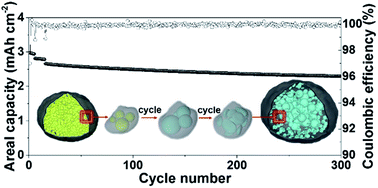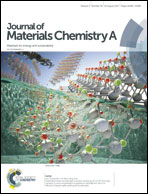Hybridizing germanium anodes with polysaccharide-derived nitrogen-doped carbon for high volumetric capacity of Li-ion batteries†
Abstract
Achieving high volumetric energy Ge anodes leaves behind a big challenge such as a huge volume expansion upon Li-ion uptake. Among various strategies, the introduction of conductive and buffering carbon layers can resolve the typical problems (such as a large volume change and poor electrical conductivity) of alloy-type anodes to some extent. On the other hand, a cost-effective and scalable synthesis method has yet to be revealed. In this study, a highly conductive carbon (ANHC) layer derived from polysaccharide with a high nitrogen-doping level (>10%) effectively mitigates the structural deformation of Ge anodes, which is also independently involved in the reversible redox reaction with an improved electrochemical performance compared to typical graphite anodes. The ANHC/Ge self-assembled by a carbothermal reduction process has remarkable anode performance in a half cell, including a stable cycle life (95% capacity retention after 500 cycles at a rate of 1C) with a high volumetric capacity of >1500 mA h cm−3 and a significant suppression of electrode swelling (<21%). In addition, the full cell consisting of the ANHC/Ge anode and LiCoO2 cathode shows excellent cyclability corresponding to a capacity retention of 73% over 300 cycles at a rate of 1C, which offers ultra-high volumetric energy applicable in various energy storage applications.



 Please wait while we load your content...
Please wait while we load your content...